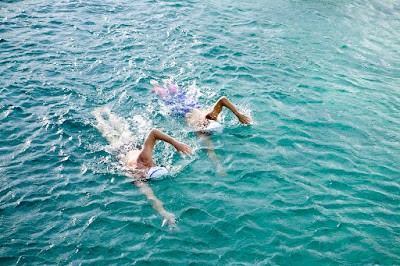Making the most of the open water
By Susan Cheshire and Sarah Hill
As the pools are still closed, we thought it would be useful
to look at how can we make the most of our time in the open water, enjoying
every moment and leaving the water a better swimmer.
Whilst our fitness levels may have changed during the
lockdown, your swim can be more than simply a physical workout; a swim session
gives us the opportunity to exercise our brains too. Being back in the water
gives us a chance to find our flow, reconnect and redevelop our feel for the
water and its myriad benefits; for many being in the water allows the stresses
of life and current challenges to melt away.
If you are swimming in open water, for some people the lack
of structure and longer distances involved can sometimes feel overwhelming and
it can be more challenging to swim with a clear plan and purpose.
We’ve put together a few ideas about how to get the best
mental and physical benefits from your open water swim:
Mentally manageable chunks – in open water it’s easy to lose
focus, so breaking up a longer distance into chunks and taking planned rests,
allows you to maintain your form so plan to swim from one buoy to the next or
the one after or maybe a full circuit but stop if your brain wanders or your stroke
deteriorates. Tread water or change stroke whilst you reset and then continue.
A reason for repeating – rather than aiming for distance,
start with swimming a number of short loops, tune into your stroke, how does it
feel? What’s good? What’s not so good? We are what we repeatedly do so learn
from every repetition; repeats allow you to identify, explore and solve
problems. Lots of repeats will increase
the distance that we swim; our priority should be to repeat and reinforce high
quality and effective movement patterns however this inevitably becomes more of
a challenge as we fatigue and our stroke deteriorates so stay mindful of how
you feel and take rests as required.
Stroke Counting – instant feedback leads to better results -
how many strokes you take to swim a given distance will give you important
information about your stroke and efficiency, apply this along with a metric
such as tempo, time or distance and you will instantly get invaluable data to
help guide your practise. This is more challenging in open water but buoy to
buoy or point to point will give you something to work with.
Honing your skill - Focal Point swimming –what is it that
you are focusing on? When Sir Dave
Brailsford become head of British Cycling in 2002 the team had almost no record
of success: British Cycling had only won
a single gold medal in its 76-year history. In the 2008 Beijing Olympics his
squad won seven out of the ten available gold medals available and then matched
this at the 2012 London Olympics. Sir
Dave applied the theory of marginal gains; by breaking down everything that
goes into competing on a bike, and then improving each element by 1%, you will
achieve a significant aggregated increase in performance. Swimming technique can and should be
approached with the same mind-set.
Swimming drills – a drill only works when it has a
point! What drills are you doing and
why? How is it improving your
swimming? In the open water try doing a
few repetitions of a drill before moving into whole stroke – what does this
highlight and what impact does it have on your stroke?
Increase the challenge and sit on the edge of your comfort
zone – this is where we thrive, we don’t always like it, it’s not meant to be
easy – but it is where we need to be to grow and improve. Test your
capabilities and limits.
Next time we’ll be looking at specific training tips for the
open water, but for now, we’ll leave the final words to Total Immersion founder
Terry Loughlin who wrote about how to see the positive in those ‘off’ days we
all have:
If it doesn’t go to plan
‘The possibility for pleasure in such difficult discipline comes from the mental atmosphere you create around your practice. It is the expectation of improvement in small details coupled with the tools you are given to actually affect those improvements which set you up for satisfaction in each practice – even when you sometimes experience more failure than success. If you succeed you get the pleasure of feeling improved movement, improved flow of water around the body. If you fail you gain insight into what details are standing in the way of your improvement and the opportunity to plan your next practice according to that insight.
Each practice can be a delight. As a matter of fact, it is
not just the stroke you are improving, it is your method of practice you are
improving – it’s your attitude about a life of continual personal improvement.
It is your whole approach to doing anything that is difficult, anything which
involves skill, which offers you the choice to resist and suffer, or accept and
improve your approach and be rewarded from day to day.’





Comments
Post a Comment